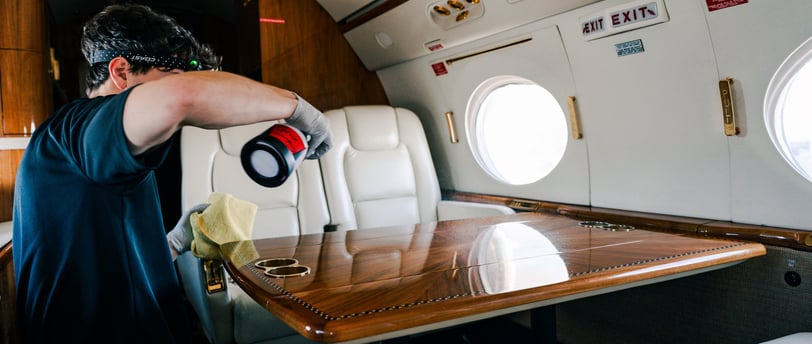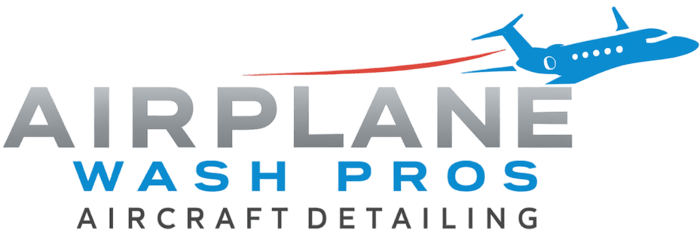Executive Jet Interior Cleaning


Executive jet interiors require more than just basic cleaning. These cabins are premium environments, built with delicate materials, sensitive electronics, and high passenger expectations. Whether you're prepping for a VIP flight or maintaining a fleet, proper interior detailing protects surfaces, preserves value, and ensures a professional passenger experience.
Here’s the interior cleaning process we use for executive jets, with tips and techniques to get results without causing wear.
Step 1: Start with a Walkthrough and Prep
Before touching anything, do a full walkthrough. Look for spills, scuffs, fingerprints, or areas showing signs of wear.
Tip
Take photos of the cabin before and after cleaning if you're offering professional services. It sets a clear standard and protects you from claims.
Hack
Turn on cabin lights and open all windows or doors. Natural light reveals smudges, crumbs, and dust that cabin lighting often hides. Remove all trash, newspapers, wrappers, or drink containers before bringing in cleaning products.
Step 2: Dust and Vacuum All Surfaces
Use a soft bristled brush to loosen dust around vents, panel seams, seat rails, and window frames. Follow up with a high suction vacuum that has soft nozzle attachments.
Hack
Use a compressed air can or a low flow blower to remove debris from cupholders, seat creases, and switches before vacuuming. It reduces the risk of pushing dust deeper.
Step 3: Clean High-Touch Areas First
Start with areas that passengers interact with most. This includes armrests, tray tables, seatbelt buckles, window sills, cabin controls, and touchscreens.
Use only aviation approved cleaning products and soft, lint-free cloths. Harsh chemicals can cloud displays or discolor leather. We like to use 303 Interior Cleaner.
Tip
Use a separate microfiber cloth just for screens. One wipe too many with a dirty rag can scratch acrylic coatings.
Step 4: Wipe Hard Surfaces
Clean cabinetry, tables, galley counters, and doors using a lightly dampened cloth with approved disinfectant. Always wipe dry after cleaning to avoid streaks or water spots.
Hack
Avoid soaking any surface. Use spray bottles to mist the cloth, not the surface. This protects electronics, wood trim, and seam seals.
Step 5: Leather Care
Most executive jets use genuine or high end synthetic leather for seats and accents. Clean using a dedicated private jet leather conditioning product. We like to use Chemical Guys Colorless and Odorless Leather Cleaner
Tip
Test on a small hidden spot before treating the entire surface. Some conditioners darken the leather slightly depending on finish.
Hack
Apply conditioner with your hand wearing a soft nitrile glove. It spreads evenly and helps you feel dry spots that need more attention.
Step 6: Carpet Cleaning and Extraction
Vacuum thoroughly, then use aircraft carpet extraction on stained or high-traffic areas. Avoid oversaturation to prevent mildew under the floor panels. We love using this portable carpet cleaner the Hoover CleanSlate Plus Portable Carpet.
Tip
Focus on entry points and aisle sections. These areas wear faster and collect dirt even on short flights.
Hack
Add a dry brush pass after extraction. It revives the carpet pile and keeps it looking fresh.
Step 7: Galley and Lavatory
Disinfect the galley carefully, avoiding food prep zones with harsh chemicals. In the lavatory, clean all surfaces with aviation-safe disinfectants and odor-neutralizers.
Tip
Use enzyme-based cleaners in the lavatory to break down odor without perfume-heavy masking sprays.
Hack
Keep individually packed sanitation wipes on board. They're great for spot-cleaning and reassuring guests between flights.
Step 8: Cockpit Area
Use sensitive cockpit cleaning practices only. Avoid applying any liquid directly near avionics. Use dry cloths, soft brushes, and only electronics-safe cleaners.
Optional
Add a cockpit detailing service session as part of full cabin deep cleaning, but always confirm with the flight crew before touching controls.
Step 9: Disinfection and Final Touches
Once cleaned, disinfect using a fogger or aviation-grade disinfectant spray approved for enclosed aircraft cabins.
Include high touchpoint sanitization jet practices every time, even on short flights. This includes door handles, light switches, oxygen masks, headset ports, and seat adjustment controls.
Tip
Lightly spray fabric-safe disinfectant on seatbelts and armrests. These are often overlooked but heavily used.
Step 10: Polish and Finish
Polish clear surfaces and windows using acrylic aircraft window cleaning spray and a clean microfiber towel. We use AeroGuard Acrylic and Plastic Windscreen Cleaner.
Add finishing touches like replacing bottled water, straightening magazines, folding blankets, and checking the galley for readiness.
Final Notes
Executive jet interior cleaning goes beyond just wiping things down. You’re preserving comfort, luxury, and reputation with every flight. Use only aviation-grade tools and take the time to treat each surface according to its material.
This type of detailing should be routine for business jet appearance management, whether you’re part of a fleet operation or an owner-operator. Interior condition plays a big role in passenger perception and long-term aircraft value.
Contact
Get in touch for your airplane cleaning needs.
Support
Follow
contact@airplanewashpros.com
+1 619-383-5893
© 2025. All rights reserved.
